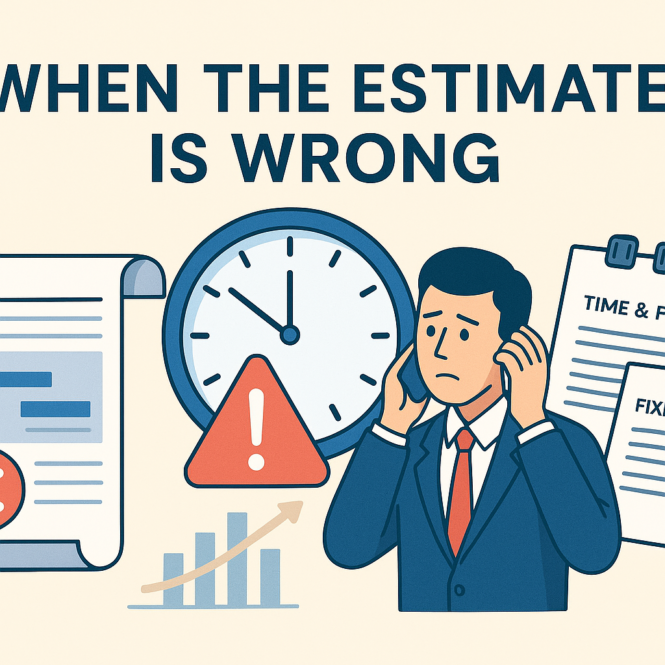
Estimates are rarely 100% accurate. Projects often run into unforeseen complications, new requirements, or misunderstood scope. But in a waterfall environment—especially where estimates have been communicated externally—the way you handle these changes is just as important as the change itself. Whether the estimate was optimistic, based on limited data, or altered by scope creep, the key is to manage expectations clearly, transparently and professionally.
Why It Matters
When estimates are wrong, reputations are at stake. Your delivery credibility, client trust, and ability to negotiate future work all rest on how you respond. If you’re working with external business customers, handling the situation poorly can have commercial consequences. If you’re internal-facing, it can still damage relationships and derail delivery.
It’s essential to have a structured, human-centred approach to dealing with estimation problems. That starts with recognising the estimate isn’t reality—it’s a snapshot based on assumptions, available knowledge, and expected effort at a point in time.
Step 1: Make Sure Your Estimate Was Framed Properly
Before you worry about correcting an estimate, you need to check how it was presented in the first place. Good estimates should always:
- Include explicit assumptions (e.g. “based on client providing final designs by X date”)
- Be linked to a timeline or milestone (e.g. “4 weeks from contract signature”)
- Be broken down into manageable components so the level of detail and accuracy is visible
- Clarify whether it’s for time and materials or a fixed price basis
This provides the foundation for any future change conversation. If you can point back to a timeline that slipped or a dependency that wasn’t met, it becomes easier to reframe expectations without the blame game.
Tip: Every estimate should be accompanied by a short assumptions log. It doesn’t need to be complex, but it needs to exist.
Step 2: Spot the Deviation Early
Whether through delivery tracking, time recording, or team check-ins, you need to spot when an estimate is off before it escalates.
- Is a task taking longer than forecast?
- Have new requirements emerged?
- Is the effort estimate holding up as the design unfolds?
Flag it early. Don’t wait for the full delay or overrun to become visible. The earlier you spot a deviation, the more room you have to adjust or re-negotiate.
Step 3: Pick Up the Phone
If your estimate was given to a business stakeholder or external customer, do not manage change through email alone.
Pick up the phone. Talk it through. Explaining the situation clearly and calmly goes a long way:
- Revisit the assumptions the original estimate was based on
- Explain what has changed and why
- Provide a revised view of impact on time, cost, or scope
- Offer options (e.g. scope reduction, phasing, increased budget)
People are far more receptive to a conversation than a written “reforecast” without context.
You’re not just delivering a message; you’re managing expectations and trust. Make it a dialogue, not a broadcast.
Step 4: Formalise the Change
Once alignment is reached verbally, follow up in writing. Use a structured change process:
- Raise a change request: capture what’s changed, why, and what decision is needed
- Assess impact: involve delivery leads, BA, tech, testing, and PM to assess implications
- Gain approval: through appropriate governance (e.g. steering group, sponsor, PM)
- Re-baseline plans: update estimates, timelines, and delivery documents
Create or update a change log so all deviations from the original estimate are recorded and visible. This isn’t about bureaucracy—it’s about control and transparency.
What If It’s Time and Materials?
In a T&M environment, changes to estimates are more flexible—but not free from scrutiny. Customers may still expect:
- Early warnings if forecast effort will be exceeded
- Explanations of why more time is needed
- Evidence of progress and justification for additional costs
T&M doesn’t mean open-ended. You still need to show good stewardship and keep stakeholders updated. A change in forecast must still be flagged, documented, and agreed.
What If It’s Fixed Price?
If you’ve committed to a fixed price and the estimate was too low, options narrow. You may need to:
- Re-scope the deliverables (defer or remove low-priority features)
- Request a formal variation (via change request or contract amendment)
- Absorb the overrun and capture it as a lessons learned
Your ability to renegotiate depends on:
- Clarity of scope in the original contract
- Evidence that the cause is outside your control
- The strength of your relationship and communication
In all cases, transparency is better than surprise. Don’t let cost overruns mount in silence.
Agile Projects: Managing Change Differently
Agile doesn’t use fixed estimates in the same way, but change still needs managing. Items added to a backlog still need to be delivered within a time-bound release. If you keep adding without constraints, you create an endless runway.
To manage estimate change in agile:
- Use sprint reviews to surface unexpected effort
- Keep the backlog prioritised with stakeholder input
- Be honest about velocity changes or blockers
The Product Owner plays a vital role here in resetting stakeholder expectations sprint-by-sprint.
Final Thought: When Estimates Go Wrong, Be Proactive
Wrong estimates don’t have to mean failed projects. But if left unmanaged, they can cause serious damage.
- Frame your estimates properly from the start
- Track progress closely and flag early
- Have the human conversation, not just the process
- Adjust formally and transparently
Great delivery isn’t about being perfect from the outset. It’s about responding professionally when things change—because they will.
Thoughts? Questions? Please share in the comments.
If you have found this article useful then you might like my book – The Business Analysis Handbook – Techniques and Questions for better Business Outcomes. The book is available from www.koganpage.com and all major print and e-book retailers including Amazon.
